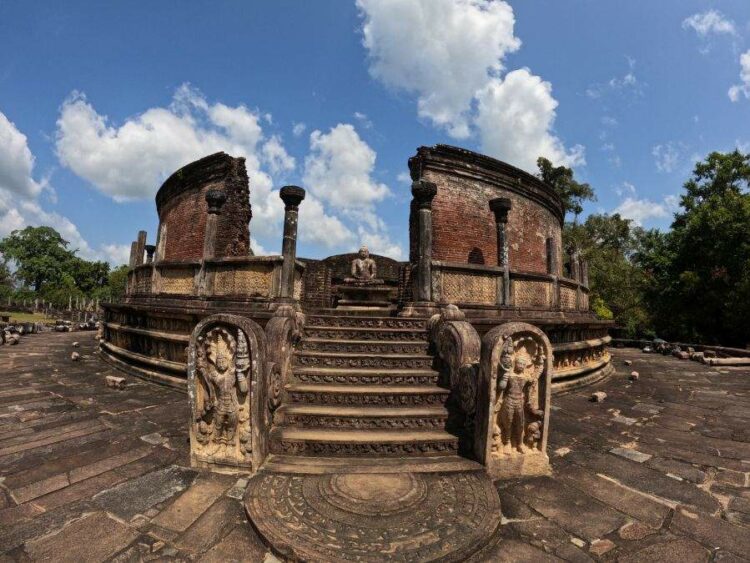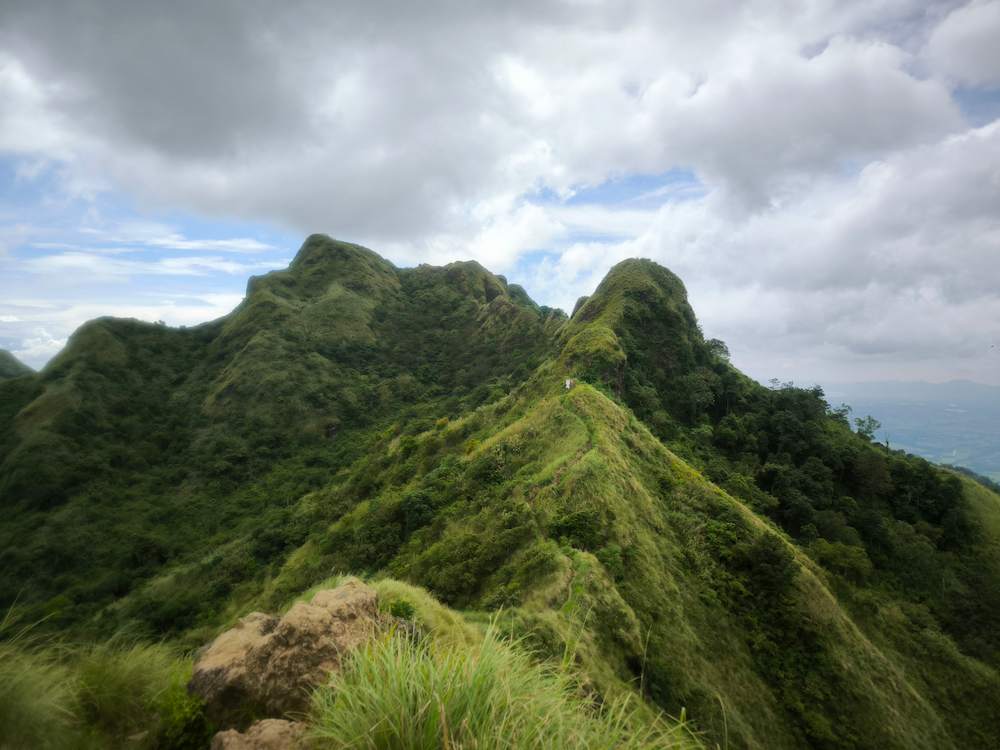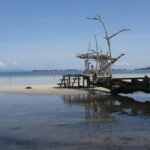General Information about Polonnaruwa Archaeological Park
The temple ruins of Polonnaruwa are located in the northern Central Province and are undoubtedly one of Sri Lanka’s highlights. Since 1982, the park has been a UNESCO World Heritage Site. Together with Anuradhapura and Kandy, they form the island’s Cultural Triangle. Within this Cultural Triangle, there are other notable sights such as the Lion Rock and Pidurangala in Sigiriya as well as the Dambulla Cave Temple.
From the 11th to 13th centuries, Polonnaruwa was the capital of the Sinhalese kingdom, succeeding the first capital, Anuradhapura. The site gives only a glimpse of the grandeur of the city that once was. Besides the Royal Palace, you will find beautiful parklands, stupas, and temples here. One of the highlights also includes the Buddha statues carved out of rock. The archaeological museum of the site features various excavations, tools, and information about life during that era.

Is a Visit to the Polonnaruwa Ruins Worth It?
Definitely! We recommend a leisurely day trip to Polonnaruwa. Arrive early in the morning, rent a bicycle, and explore the site at your own pace.
What is the Best Time to Visit the Temple Complex of Polonnaruwa?
I can already dispel an illusion – the temple complex is always well-visited, as it is one of the highlights of the country. The advantage is that you can visit it year-round and in any weather; in fact, cloudy skies can make the ruins look even more dramatic. The benefit is that the site is very spacious, so visitor flows are well distributed across the entire area. It is recommended to visit as early as possible to avoid the midday heat. The ruins open at 7:00 AM.
Top Tips for Your Visit to Polonnaruwa
Wear socks – you need to remove your shoes before entering the temples, and the stones can get very hot.Explore the site by bicycle.
Bring enough water and sunscreen as it gets very warm.
Consider taking the bus to save costs.
Take your time to visit Polonnaruwa; don’t try to combine Sigiriya and the ruins in one day.
Visit the museum first to better understand the context of the site.
Is a Guide Worth It for Polonnaruwa?
This largely depends on how deeply you want to delve into the history and symbolism of the individual structures and stupas. I highly recommend hiring a guide, as it allows you to fully understand the significance of the site rather than just admiring the ruins. While you can find explanations online and in the museum, hearing the context explained in person can offer a richer experience. We visited Polonnaruwa without a guide but were able to listen to some explanations from other groups.
Highlights of Polonnaruwa
There is much to discover in Polonnaruwa. Here are some temples, stupas, and statues that we particularly enjoyed:
Satmahal Prasada Pyramid Temple

The Satmahal Prasada Pyramid Temple is located in the northeastern part of the park. Built in the 12th century, its creator is unknown. It is the only temple of its kind in the area and its pyramid-like structure is reminiscent of Buddhist temples in Cambodia or Thailand. The square pyramid originally had 7 tiers but now has 6.
Rankoth Vehera

The Rankoth Vehera was built at the end of the 12th century. This stupa is situated on a large square platform with four entrances leading to the stupa.
Vatadage
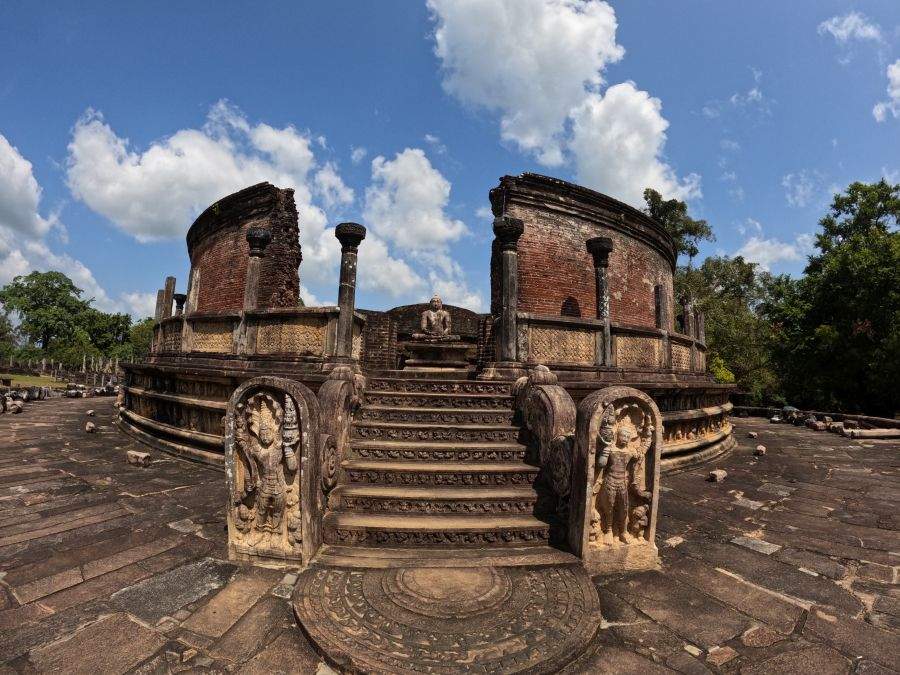
A Vatadage is a Buddhist building designed to protect a small stupa located in the center of the circular structure. There are four entrances to the Vatadage, making it one of the most photogenic structures in Polonnaruwa.
Gal Vihara
The special feature of the Gal Vihara Temple is the four Buddha statues carved into the granite rock. The standing Buddha is about 7 meters tall, the reclining Buddha measures 14 meters in length, and the two seated Buddhas are 4.5 meters and 1.40 meters tall respectively. The reclining Buddha is one of the largest Buddha statues in Southeast Asia.

Weijantha Prasada The Former Royal Palace
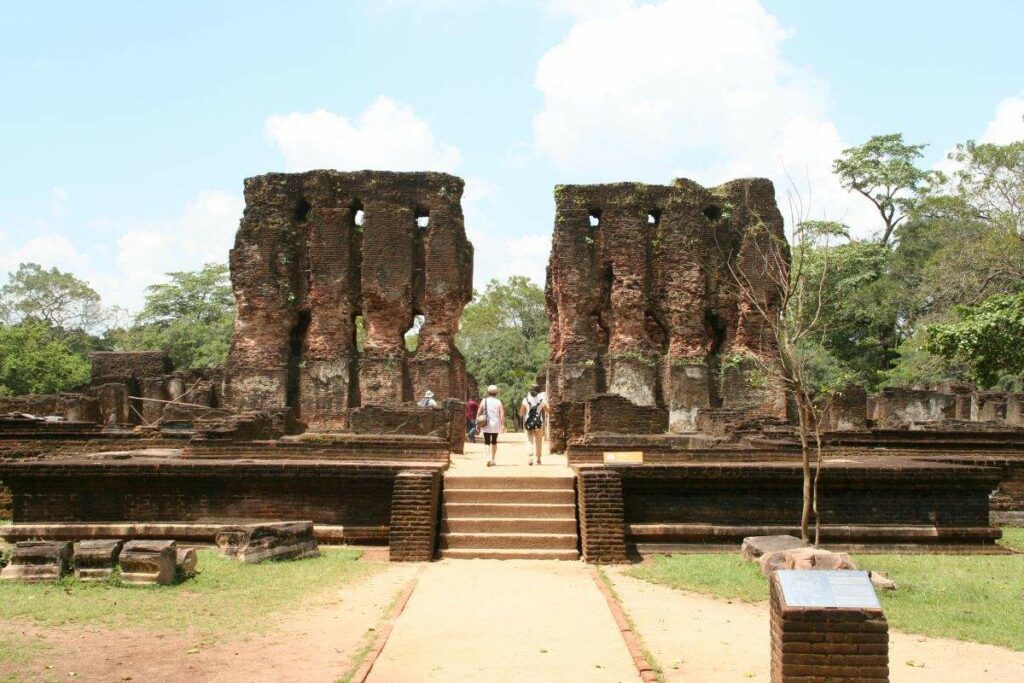
The ruins of the Royal Palace only hint at the grandeur of the building that once stood here.
How Much Does It Cost to Enter the Polonnaruwa Ruins?
Unfortunately, the entrance fees in Sri Lanka, especially for Polonnaruwa and the Lion Rock of Sigiriya, do not align with the general cost of living in the country. The entrance fee is 5,000 LKR per person (approximately 22 €).
How to Get to the Polonnaruwa Ruins
As briefly mentioned earlier, there are several ways to get to Polonnaruwa. We will show you the different options here. You should generally consider whether you want to stay overnight in Polonnaruwa or prefer another place like Sigiriya.
Getting There by Scooter or Tuk-Tuk
We traveled from Sigiriya to Polonnaruwa and back with our rented tuk-tuk. The drive takes about 1.5 to 2 hours. If you travel in the afternoon, you might have a good chance of encountering wild elephants on the way. But be cautious!!! Keep a safe distance, do not honk, and wait until the elephants pass by or slowly drive past them with sufficient distance if they are walking along the road.
Getting There by Bus
The super-budget option to get to Polonnaruwa is by bus. However, this requires either a tuk-tuk ride or a decent walk. The bus travels along the A11 highway and is generally the cheapest mode of transportation in Sri Lanka. From Sigiriya, it’s best to take a tuk-tuk to Inamaluwa Junction. See the map below. In Polonnaruwa, the bus stops about half a kilometer away from the ticket office. The key to bus travel in Sri Lanka is communication with the driver. You can take any bus heading east from the junction; the question is how far it goes. The bus fare should be no more than LKR 150 (~0.75 €).
Getting There by Tour/Taxi/Tuk Tuk
If you prefer to leave the organization of your trip to others, you can join a tour or hire a private driver. There are plenty of options available.
[WPSM_AC id=3536]


